传播学经典理论英文版打印
传播学经典理论英文翻译(可编辑修改word版)

1.O pinion LeadersActive in information networks, have many information channels ,so they can often provide information and advice for others and can influence others.2.T he Spiral of SilenceFor a controversial issue, people will watch the "climate of opinion" before they make comments . judging their opinion whether the "majority opinion", when people feel that their views are "majority" or in the "advantage" , it will tend to boldly express this opinion; when found his views are "a few" or in a "disadvantage" they often remain "silent." The more people remain silent, the more feel that their views are not well accepted, thus a result, the more they tend to remain silent. Repeated several times, they form representing "dominant" status views and more powerful, while holding "inferior" opinions of people sound more and more weak, such a cycle, forming a "one more loudly, and the other more and more silent spiral down the process. "3.GatekeeperLewin was first proposed this idea.The information was screened and filtered by communicator. Communicators decide what we can see and how we can see .4.Selective exposure hypothesisAudience in the contact information of the mass media is notindiscriminate, but more willing to choose the contents that are the same or similar to their opinion, and for the contents of this confrontation or conflict, there is a tendency to avoid.5.K nowledge Gap TheoryBecause the people who have higher economic status is usually much faster to get information than those of low socioeconomic status, therefore, the more information is transmitted by the mass media , the knowledge gap between the two types of people is more tend to expand.6.A genda Setting TheoryMass media report an issue or not directly affect people's perception on the subject.Mass media highlights an issue will cause people to pay more attention to the issue.Mass media on a range of topics give different levels of coverage according to a certain order of priority, it will affect people’s judgment about importance of these issues .7.M agic bullet theoryThe message sent by the mass media is like a magic bullet, but the audience as the target without protection ,so the audience can easily be knocked down by the message sent by the mass media.The theory is that mass media have powerful force which can directly affect audience.Text One An Introduction to Communicationii) Key Words & Expressions:communication n. 传播journalism n. 新闻学transfer n.& v. 传递,迁移information n. 信息circulation n. 流通,运行,循环,传播convey v. 传送,传递feedback n. 反馈,反应medium n. 媒体,媒介,中介II. Text StudySTUDY PREVIEW communication is an important word in our today’s academic study in journalism, sociology, psychology, economics & politics. It’s also heard more & more often in our daily life. So what is communication?Communication:The transfer of social information & the circulation of social information systems.Social:When we say “communication” in our study, we usually mean human communication, not animal communication; a “communication” happening in a society, not in other environments such as natural, physical or biological ones.Why we study “human communication”?Communication is the tool that makes societies possible. It is no accident that communication and community have the same word root.Without communication, there would be no communities; and without community, there could be no communication.The sociologist Charles Cooley called communication “the mechanism through which human relations exist and develop_ all the symbols of the mind, together with the means of conveying them through space and preserv ing them in time”.Transfer of information:When “communication” happens, information flows from one person to another, and then the receiver may give some feedback to the giver. During this process, the information is shared, and the giver and receiver can play the opposite role.Also, communication needs some medium, which is something both parts of a communication can understand. For example, two or more people come together, trying to share some information. But they are from different countries and have different life experiences. So if they want to understand one another, they must use some medium such as English language, or even body language.In modern times, words are important tools or media for communication. But communication is not conducted entirely, or even mostly, in words. A gesture, a facial expression, a pitch pattern, a level of loudness, an emphasis, a kiss, a hand on the shoulder, a haircut or lack of one _ all these carry information.Text Two Types of Communicationii) Key Words & Expressions:mass media 大众传播媒体mass communication 大众传播intrapersonal communication 自我传播interpersonal communication 人际传播group communication 群体传播audience 受众,观众,听众encode 编码code 代码transmit 传输,传达,传播decode 解码internalize 使内在化II. Text StudySTUDY PREVIEW The communication in which the mass media engage is only one form of communication. One way to begin understanding the process of mass communication is to differentiate it from other forms of communication.Intrapersonal CommunicationWe engage in intrapersonal communication when we talk to ourselves to develop our thoughts and ideas. This intrapersonal communication precedes our speaking or acting.Intrapersonal communication is an exchange of information we have with ourselves, such as when we think over our next move in a video game or sing to ourselves in the shower. Typing into a computer is electronically mediated intrapersonal communication.Interpersonal CommunicationWhen people talk to each other, they are engaging in interpersonal communication. In this simplest form, interpersonal communication is between two people physically located in the same place. It can occur, however, if they are physically separated but emotionally connected, like lovers on cell phones.The difference between the prefixes intra- and inter- is the key difference between intrapersonal and interpersonal communication. Just as intrasquad athletic games are within a team, intrapersonal communication is within one’s self. Just as intercollegiate games are between schools, interpersonal communication is between individuals.Interpersonal communication includes exchanges in which two or more people take part, but the term is usually reserved for situations in which just two people are communicating. Having a face-to-face conversation over lunch and writing a letter to a friend are everyday examples. When interpersonal communication is electronically mediated, as in a telephone conversation, the term point-to-point communication is sometimes used.Group CommunicationThere comes a point when the number of people involved reduces the intimacy of the communication process. That’s when the situation becomes group communication. A club meeting is an example. So is a speech to an audience in an auditorium.Mass CommunicationCapable of reaching thousands, even millions, of people is mass communication, which is accomplished through a mass medium like television or newspapers. Mass communication can be defined as the process of using a mass medium to send messages to large audiences for the purpose of informing, entertaining or persuading.In many respects the process of mass communication and other communication forms is the same: Someone conceives a message, essentially an intrapersonal act. The message then is encoded into a common code, such as language. Then it’s transmitted. Another person receives the message, decodes it and internalizes it. Internalizing a message is also an intrapersonal act.In other respects, mass communication is distinctive. Crafting an effective message for thousands of people of diverse backgrounds and interests requires different skills than chatting with a friend across the table. Encoding the message is more complex because a device is always used-for example, a printing press, a camera or a recorder.One aspect of mass communication that should not be a mystery is the spelling of the often-misused word communication. The word takes no “s” if you are using it to refer to a process. If you are referring to a communication as a thing, such as a letter, a movie, a telegram or a television program, rather than a process, the word is communication insingular form and communication in plural. When the term mass communication refers to a process, it is spelled without the “s”.Review:communication: Exchange of ideas,information.intrapersonal Communication: Talking to oneself.interpersonal Communication: Usually two people face to face.group Communication: More than two people; in person.mass Communication: Many recipients; not face to face; a process.Text Three Components of Mass CommunicationSTUDY PREVIEW Mass communication is the process that mass communicators use to send their mass messages to mass audiences. They do this through the mass media. Think of these as the Five Ms: mass communicators, mass messages, mass media, mass communication and mass audience.Mass CommunicatorsThe heart of mass communication is the people who produce the messages that are carried in the mass media. These people include journalists, scriptwriters, lyricists, television anchors, radio disc jockeys, public relations practitioners and advertising copywriters. The list could go on and on.Mass communicators are unlike other communicators because they cannot see their audience. David Letterman knows that hundreds of thousands of people are watching as he unveils his latest Top 10 list, but he can’t se e them or hear them chuckle and laugh. He receives no immediate feedback from his mass audience. This communicating with an unseen audience distinguishes mass communication from other forms of communication. Storytellers of yore told their vocabulary according to how they sensed they were being received. Mass communicators don’t have that advantage, although a studio audience.Mass MessagesA news item is a mass message, as are a movie, a novel, a recorded song and a billboard advertisement. The message is the most apparent part of our relationship to the mass media. It is for the messages that we pay attention to the media. We don’t listen to the radio, for example, to marvel at the technology. We listen to hear the music.Mass MediaThe mass media are the vehicles that carry messages. The primary mass media are books, magazines, newspapers, television, radio, sound recordings, movies and the web. Most theories view media as neutral carriers of messages. The people who are experts at media include technicians who keep the presses running and who keep the television transmitters on the air. Media experts also are tinkers and inventors whocome up with technical improvements, such as compact discs, DVDs, AM stereo radio and newspaper presses that can produce high-quality color.Mass CommunicationThe process through which messages reach the audience via the mass media is called mass communication. This is a mysterious process about which we know far less than we should. Researchers and scholars have unraveled some of the mystery, but most of how it works remains a matters of wonderment. For example, why do people pay more attention to some messages than to others? How does one advertisement generate more sales than another? Is behavior, including violent behavior, triggered through the mass communication process? There is reason to believe that mass communication affects voting behavior, but how does this work? Which is most correct-to say that people can be controlled by mass communication? Or manipulated? Or merely influenced? Nobody has the answer.Mass AudiencesThe size and diversity of mass audiences add complexity to mass communication. Only indirectly do mass communicators learn whether their messages have been received. Mass communicators are never sure exactly of the size of audiences, let alone of the effect of their messages. Mass audiences are fickle. What attracts great attention one day may notthe next. The challenge of trying to communicate to a mass audience is even more complex because people are tuning in and tuning out all the time, and when they are tuned in, it is with varying degrees of attentiveness.Review:mass Communicators: Message crafters.mass Message: What is communicated.mass Media: Vehicles that carry messages.mass Audiences: Recipients of mass messages.Text Four Communication Modelsii) Key Words & Expressions:communication model 传播模式narrative model 线性模式system model 系统模式the SMCR model 施拉姆模式concentric circle model 同心圆模式Claude Shannon 香农Warren Weaver 韦弗Harold Lasswell 拉斯韦尔Wilbur Schramm 施拉姆Thomas Bohn 波恩II.Text StudySTUDY PREVIEW Scholars have devised models of thecommunication process in an attempt to understand how the process works. Like all models, these are simplifications and are imperfect. Even so, these models bring some illumination to the mysterious communication process.Role of Communication ModelsHobbyists build models of ships, planes, automobiles and all kinds of other things. These models help them see whatever they are modeling in different ways. Industrial engineers and scientists do the same thing, learning lessons from models before they actually build something to full scale. Communication models are similar. By creating a facsimile of the process, we hope to better understand the process.A reality about models is that they are never perfect. This reality is especially true when the subject being modeled is complex. An architect, for example, may have a model of what the building will look like to passersby, but there also will be models of the building’s heating system, traffic patterns, and electrical, plumbing and ventilation systems. None of these models is complete or accurate in every detail, but all nonetheless are useful.Communication models are like that. Different models illustrate different aspects of the process. The process itself is so complex that no single model can adequately cover it.Basic ModelTwo Bell telephone engineers, Claude Shannon and Warren Weaver, laid out a basic communication model in 1948. They were working on advanced switching systems. The model, fundamentally a simple diagram, gave them a reference point for their work. That model has become a standard baseline for describing the communication process. The Shannon-Weaver model identifies five fundamental steps in the communication process:○The human stimulation that results in a thought.○The encoding of the thought into a message.○The transmission of the message.○The decoding of the message by the recipient into a thought.○The internalization of the message by the recipient.Narrative ModelYale professor Harold Lasswell, an early mass communication theorist, developed a useful yet simple model that was all words-no diagram. Lasswell’s narrative model poses four questions: Who says what? In which channel? To whom? With what effect?You can easily apply the model. Pick any bylined story from the front page of a newspaper.○Who says what? The newspaper reporter tells a story, often quoting someone who is especially knowledgeable4 on the subject.○In which channel? In this case the story is told through thenewspaper, a mass medium.○To whom? The story is told to a newspaper reader.○With what effect? The reader decides to vote for Candidate A or B, or perhaps readers just add the information to their reservoir of knowledge.The SMCR ModelThe classic model that stresses the dominance of the media was developed by Wilbur Schramm (1982), often credited as the founder of mass communication studies. He created what is known as the Source- Message-Channel-Receiver (SMCR) model.The Source-Message-Channel-Receiver (SMCR) model describes the exchange of information as the message passes from the source to the channel to the receiver, with feedback to the source.The source is the originator of the communication.The message is the content of the communication, the information that is to be exchanged.An encoder translates the message into a form that can be communicated- often a form that is not directly interpretable by human senses.A channel is the medium or transmission system used to convey the message from one place to another.A decoder reverses the encoding process.The receiver is the destination of the communication.A feedback mechanism between the source and the receiver regulates the flow of communication.Noise is any distortion or errors that may be introduced during the information exchange.This model can be applied to all forms of human communication, but here we will just illustrate it with mass communication examples. When you are at home watching a television program, the television network (a corporate source) originates the message, which is encoded by the microphones and television cameras in the television studio. The channel is not literally the number on the television dial to which you are tuned, but rather the entire chain of transmitters, satellite links, and cable television equipment required to convey the message to your home. Although we sometimes call a TV set a “receiver,” it is really the decoder and the viewer is the receiver. Feedback from viewers is via television rating services. Electronic interference with the broadcast and the distractions of barking dogs are possible noise components in this situation. The source of a message, which the author encoded with the software she used to comp ose the page’s content. The channel is the Internet, including the computer that the Web page is stored on, and the network connections between that computer, called a server, and your own. Your computer acts as the decoder. It decodes the message with your browser software (such as Netscape or Internet Explorer), and youare the receiver.In this classic view, mass communication is one-to-many communication, and the mass media are the various channels through which mass communication is delivered. That is, through newspapers, radio, TV, or film, the message is communicated from a single source to many receivers at about the same time, with limited opportunities for the audience to communicate back to the source.Concentric Circle ModelThe Shannon-Weaver model can be applied to all communication, but it misses some things that are unique to mass communication. In 1974 scholars Ray Hiebert, Donald Ungurait and Thomas Bohn presented an important new model-a series of concentric circles with the encoding source at the center. One of the outer rings was the receiving audience. In between were several elements that are important in the mass communication process but less so in other communication processes.The concentric circle model is one of the most complete models for identifying elements in the mass communication process, but it misses many complexities. It takes only one message from its point of origin, but in reality thousands of messages are being issued simultaneously. Audiences receive many of these messages, but not all of them, and the messages are received imperfectly. Feedback resonates back to communicators unevenly, often ill-based. Gatekeeping too is uneven. Inshort, there are so many variables that it is impossible to track what happens in any kind of comprehensive way.III.Review:Claude Shannon: Devised a basic communication model, with Warren Weaver.Warren Weaver: Devised a basic communication model, with Claude Shannon.basic communication model: Shows sender, encoding, transmission, decoding, receiver.Harold Lasswell: Devised the narrative model.narrative model: Describes process in words, not schematic.Thomas Bohn: Devised the concentric circle model, with Ray Hiebert, Donald Ungurait.concentric circle model: Useful radiating model of the mass communication process.Text Five Fundamentals in the Processii) Key Words & Expressions:homophyly n. 类似性tabloid n. 小报stimulation n. 刺激encoding n. 编码transmission n. 传递decoding n. 解码internalization n. 内化STUDY PREVIEW Most models for mass communication as well asother communication forms share some fundamental elements. The elements are sequential, beginning with whatever stimulates a person to want to communicate and continuing through encoding and transmission. To complete the communication process, the recipient of the message must decode and internalize it.StimulationBoth the Shannon-Weaver model and the concentric circle model begin with a source who is stimulated to want to communicate a message. The stimulation can result from many things. Emotions can be stimuli, as can something that is sensed. The stimulation can be as diverse as seeing a beautiful panorama or hearing a child cry.EncodingThe second step is encoding. The source puts thoughts into symbols that can be understood by whomever is destined to receive the message. The symbols take many forms-for example, the written word, smoke signals or pictographs.TransmissionThe message is the representation of the thought. In interpersonal communication the message is almost always delivered face to face. In mass communication, however, the message is encoded so that it is suitable for the equipment being used for transmission. Shannon and Weaver, being telephone engineers in the 1940s, offered the example ofthe sound pressure of a voice being changed into proportional electrical current for transmission over telephone lines. In technical terms, telephone lines were channels for Shannon and Weaver’s messages. On a more conceptual basis the telephone lines were the media, in the same way that the printed page or a broadcast signal is.DecodingThe receiver picks up signals sent by the transmitter. In interpersonal communication the receiver is a person who hears the message, sees it, or both. An angry message encoded as a fist banging a table is heard and perhaps felt. An insulting message encoded as a puff of cigar smoke in the face is smelled. In mass communication the first receiver of the message is not a person but the equipment that picks up and then reconstructs the message from the signal. This mechanical decoding is necessary so that the human receiver of the message can understand it. As Shannon and Weaver put it: “The receiver ordinarily performs the inverse operation that was done by the transmitter. ”InternalizationIn mass communication a second kind of decoding occurs with the person who receives the message from the receiving equipment. This is an intrapersonal act, internalizing the message. For this second kind of decoding to work, the receiver must understand the communication form chosen by the source in encoding. Someone who reads only English willnot be able to decode a message in Greek. Someone whose sensitivities are limited to punk rock will not understand Handel’s “Water Music.” In other words, the source and the receiver must have enough in common for communication to occur. This common experience, which can be as simple as speaking the same tongue, is called homophyly. In mass communication the encoder must know the audience well enough to shape messages that can be decode accurately and with the intended effect.The audience and how it perceives a message are essential in the mass communication process. This is no better illustrated than in a front- page headline in the National Examiner, a sensationalizing weekly tabloid: “Cops Think Kato Did It!” Brain “Kato” Kaelin was a pal of O. J. Simpson and had been subjected to police interviewing off and on for months before the Simpson murder trial. Kaelin sued the Examiner over the headline. In court, the Examiner said the “it” in the headline didn’t refer to the murders but to possible perjury. The Examiner argued that “it” was expl ained in a secondary head on Page 1: “…He Fears They Want Him for Perjury. ”A three-judge federal appeals court sided with Kaelin, saying that Examiner readers were likely to infer that the police thought he was a murder. This was despite the fact that th e story made it clear that “it” was perjury, not murder, and also despite the secondary Page 1head.The judges noted that the headline came only a week after the widely reported Simpson acquittal and that, in the court’s opinion, people who h ad followed the trial reasonably could have interpreted “it” to be murder. The decision allowed Kaelin to pursue his $15 million legal action against the Examiner.For mass communicators the lesson is that strict, literal meanings are not always enough. Audience inferences, part of the intrapersonal decoding process, must also be considered.stimulation: Stirs someone to communicate.encoding: Putting something into symbols.transmission: Sending a message. decoding:Translating a symbolic message.internalization: Making sense of a decoded message.homophyly: A coding oneness that makes communication possible.。
英文总结修订版传播学名词解释
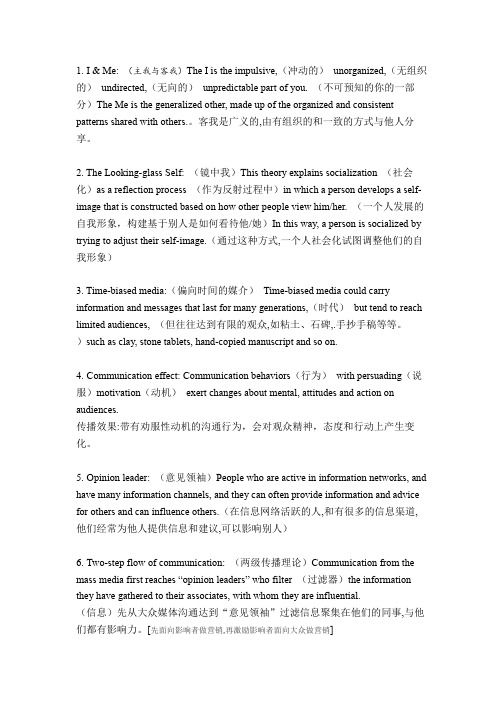
1. I & Me: (主我与客我)The I is the impulsive,(冲动的)unorganized,(无组织的)undirected,(无向的)unpredictable part of you. (不可预知的你的一部分)The Me is the generalized other, made up of the organized and consistent patterns shared with others.。
客我是广义的,由有组织的和一致的方式与他人分享。
2. The Looking-glass Self: (镜中我)This theory explains socialization (社会化)as a reflection process (作为反射过程中)in which a person develops a self-image that is constructed based on how other people view him/her. (一个人发展的自我形象,构建基于别人是如何看待他/她)In this way, a person is socialized by trying to adjust their self-image.(通过这种方式,一个人社会化试图调整他们的自我形象)3. Time-biased media:(偏向时间的媒介)Time-biased media could carry information and messages that last for many generations,(时代)but tend to reach limited audiences, (但往往达到有限的观众,如粘土、石碑,.手抄手稿等等。
)such as clay, stone tablets, hand-copied manuscript and so on.munication effect: Communication behaviors(行为)with persuading(说服)motivation(动机)exert changes about mental, attitudes and action on audiences. 传播效果:带有劝服性动机的沟通行为,会对观众精神,态度和行动上产生变化。
英文版传播学教材书目
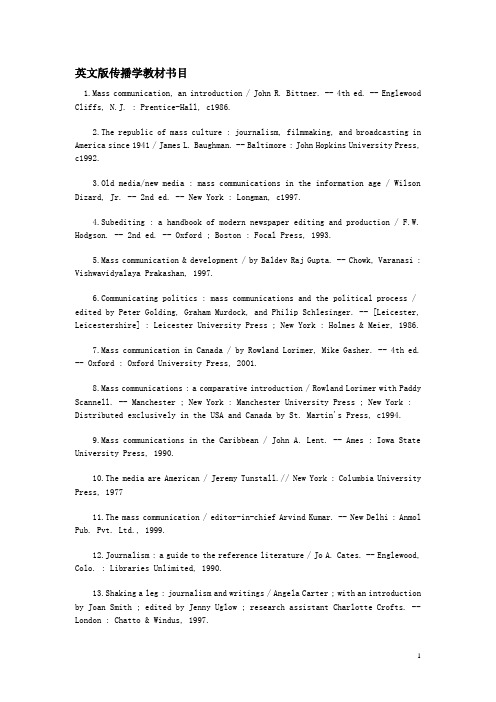
英文版传播学教材书目1.Mass communication, an introduction / John R. Bittner. -- 4th ed. -- Englewood Cliffs, N.J. : Prentice-Hall, c1986.2.The republic of mass culture : journalism, filmmaking, and broadcasting in America since 1941 / James L. Baughman. -- Baltimore : John Hopkins University Press, c1992.3.Old media/new media : mass communications in the information age / Wilson Dizard, Jr. -- 2nd ed. -- New York : Longman, c1997.4.Subediting : a handbook of modern newspaper editing and production / F.W. Hodgson. -- 2nd ed. -- Oxford ; Boston : Focal Press, 1993.5.Mass communication & development / by Baldev Raj Gupta. -- Chowk, Varanasi : Vishwavidyalaya Prakashan, 1997.municating politics : mass communications and the political process / edited by Peter Golding, Graham Murdock, and Philip Schlesinger. -- [Leicester, Leicestershire] : Leicester University Press ; New York : Holmes & Meier, 1986.7.Mass communication in Canada / by Rowland Lorimer, Mike Gasher. -- 4th ed. -- Oxford : Oxford University Press, 2001.8.Mass communications : a comparative introduction / Rowland Lorimer with Paddy Scannell. -- Manchester ; New York : Manchester University Press ; New York : Distributed exclusively in the USA and Canada by St. Martin's Press, c1994.9.Mass communications in the Caribbean / John A. Lent. -- Ames : Iowa State University Press, 1990.10.The media are American / Jeremy Tunstall.// New York : Columbia University Press, 197711.The mass communication / editor-in-chief Arvind Kumar. -- New Delhi : Anmol Pub. Pvt. Ltd., 1999.12.Journalism : a guide to the reference literature / Jo A. Cates. -- Englewood, Colo. : Libraries Unlimited, 1990.13.Shaking a leg : journalism and writings / Angela Carter ; with an introduction by Joan Smith ; edited by Jenny Uglow ; research assistant Charlotte Crofts. -- London : Chatto & Windus, 1997.14.From fact to fiction : journalism and imaginative writing in America. -- New York : Oxford Univ. Pr., 1985.15.The Sun shines for all : journalism and ideology in the life of Charles A. Dana / Janet E. Steele. -- 1st ed. -- Syracuse, N.Y. : Syracuse University Press, 1993.16.Cyberspace : and the repositioning of corporations / S. Shiva Ramu. -- Hyderabad, India : Universities Pr. (India) Ltd., c199917.Journalism, literature, and modernity : from Hazlitt to Modernism / edited by Kate Campbell. -- Edinburgh : Edinburgh University Press, c2000.18.A journalist's guide to sources / David Spark. - Oxford ; Boston : Focal Press, 1996.19.Journalism in the digital age : theory and practice for broadcast, print and on-line media / John Herbert. -- Oxford ; Boston : Focal Press, 2000.20.American politics in the media age / Thomas R. Dye, Harmon Zeigler.//Monterey, Calif. : Brooks/Cole Pub. Co., c1986.21.Practical newspaper reporting / Geoffrey Harris and David Spark ; edited, with additional material, by F.W. Hodgson. -- 3rd ed. -- Oxford ; Boston : Focal Press, 1997.22.Journalism : contributions to Commonweal, 1885-1890 / William Morris ; edited and introduced by Nicholas Salmon. -- Bristol, U.K. ; [Washington, DC] : Thoemmes Press, 1996.23.The journalism. edited by Herbert Bergman ; Douglas A. Noverr, Edward J. Recchia, associate editors. -- New York : P. Lang, 1998.24.Journalism workbook : a manual of tasks and resources. -- Oxford : Focal Press, 1995.25.The American chronicles of Jose Marti : journalism and modernity in Spanish America / Susana Rotker ; translated from the Spanish by Jennifer French and Katherine Semler. -- Hanover, NH : University Press of New England, c2000. (Reencounters with colonialism--new perspectives on the Americas)26.Access to media: a guide to integrating and computerizing catalogs / Intner, Sheila S. //New York Neal-Schuman Publishers, 1984.27.Creating online media : a guide to research, writing, and design on the Internet / Carole Rich // Boston : McGraw-Hill, 199828.America's schools and the mass media/edited by Everette E. Dennis, Craig L. LaMay. ; New Brunswick, N.J. //Transaction Publishers, c1993.29.Mass communication : teaching and studies at universities : a world-wide survey on the role of universities in the study of the mass media and mass communication / May Katzen //Paris : Unesco Press, 1975.30.Journalism in the United States, from 1690-1872 / Frederic Hudson. -- London : Routledge/Thoemmes Pr., 2000. -- 2 v. -- (American journalism : 1690-1940 ; 1-2)31.The mass media book. Edited by Rod Holmgren [and] William Norton.// Englewood Cliffs, N.J., Prentice-Hall [1972]32.Writing for the mass media/James Glen Stovall.//Englewood Cliffs, NJ Prentice Hall, c1990.33.A culture for democracy : mass communication and the cultivated mind in Britain between the wars / by D.L. LeMahieu. -- Oxford [England] : Clarendon Press ; New York : Oxford University Press, 1988.。
20世纪传播学经典文本

20世纪传播学经典文本1. "媒介的定义和效果" (The Medium is the Message)- 马歇尔·麦克卢汉(Marshall McLuhan)这篇经典文本探讨了媒介对人类思维、行为和社会的深远影响,麦克卢汉认为媒介本身就是一条信息,不仅传递内容,而且也塑造我们的经验和感知。
2. "公共领域景观" (The Public Realm: Exploring the City's Dominant Theme)- Jürgen Habermas这本书探讨了公共领域和城市的互动关系,强调了公共空间对于民主社会和公民参与的重要性。
3. "传播与社会文化理论" (Communication and Society: Theories and Research)- James Carey这本书是传播学领域的经典教材,涵盖了多个传播和社会文化的理论,从传媒效果到传媒批判,深入剖析了传播的各个层面和影响。
4. "危机与传播" (Crisis Communication and Crisis Management: An Ethical Approach)- Timothy L. Sellnow和Matthew W. Seeberger这本书研究了危机情况下的传播和管理,对于组织如何应对危机时的传播策略和道德问题进行了探讨。
5. "媒介与现代性" (Media and Modernity: A Social Theory of the Media)- John B. Thompson这本书研究了媒介如何塑造现代社会和现代性的理论,涵盖了从印刷媒介到电视和互联网的发展,并分析了媒介与社会关系的相互作用。
这些经典文本代表了20世纪传播学领域的重要思想和理论,对于理解传播的本质和影响具有重要意义。
传播学专业英语

Chapter One Introduction to Mass Communication♦Key Termscommunication 传播,交通:mass communication, be in communication with,feedback 反馈: asked the students for feedback on the new curriculum.interpersonal communication 人际传播:interpersonal relationshipsencoding 编码: audio encoding, hybrid encodingdecoding 解码: adaptive decodingpublic relations 公共关系noise 噪音,响声,无用数据,吸引注意的言行medium 媒介(media),手段,mass medium 大众媒介,大众传播工具,影响大量观众的一种公众媒介mass communication 大众传播,大众传播工具inferential feedback 推断性反馈reciprocal messages 交互讯息:(reciprocal互惠的,彼此相反的)cultural definition of communication 传播的文化定义dominant culture (mainstream culture)主流文化bounded culture (co-culture) 亚文化: bounded functiontechnological determinism 技术决定论: (determinism决定论,宿命论)visual communication 视觉传播third participant 第三方:(participant 参与者,参与的)concentration of ownership 所有权集中convergence 融合,会合点,集中,收敛conglomeration 集团化,混合物,凝聚:The state of being conglomeratedeconomies of scale 规模经济;因经营规模扩大而得到的经营节约oligopoly 寡头式的垄断,求过于供的市场情况(oligopolies)globalization 全球化:globalizeaudience fragmentation 受众分析:(audience:听众,观众,读者。
传播学概论英文版

External Communication
Explore strategies for managing public relations and maintaining a positive organizational image.
Leadership Communication
Discover the role of communication in effective leadership and management practices.
Organizational Communication and Management
Internal Communication
Learn how effective communication can enhance productivity and collaboration within organizations.
Privacy and Ethics in Social Media
Examine the ethical challenges and privacy implications of social media use.
Explore how social media platforms shape individual and collective identities.
Explore the dynamics of interpersonal communication and how it influences personal and professional relationships.
Intercultural Communication and Diversity
西方新闻传播学经典文库
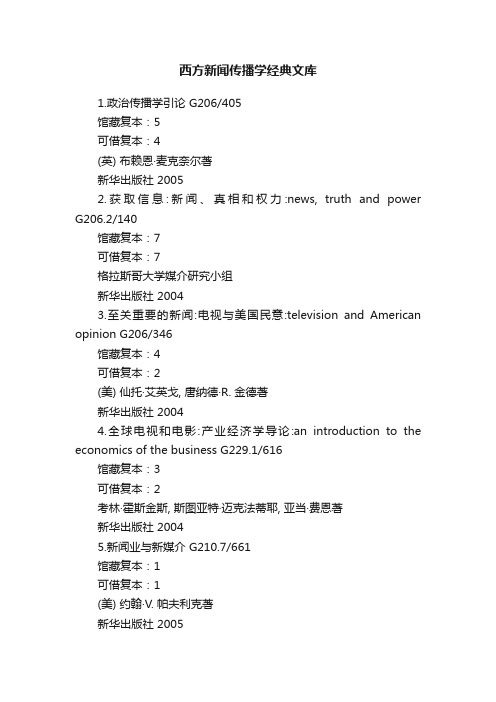
西方新闻传播学经典文库1.政治传播学引论 G206/405馆藏复本:5可借复本:4(英) 布赖恩·麦克奈尔著新华出版社 20052.获取信息:新闻、真相和权力:news, truth and power G206.2/140馆藏复本:7可借复本:7格拉斯哥大学媒介研究小组新华出版社 20043.至关重要的新闻:电视与美国民意:television and American opinion G206/346馆藏复本:4可借复本:2(美) 仙托·艾英戈, 唐纳德·R. 金德著新华出版社 20044.全球电视和电影:产业经济学导论:an introduction to the economics of the business G229.1/616馆藏复本:3可借复本:2考林·霍斯金斯, 斯图亚特·迈克法蒂耶, 亚当·费恩著新华出版社 20045.新闻业与新媒介 G210.7/661馆藏复本:1可借复本:1(美) 约翰·V. 帕夫利克著新华出版社 20056.网络研究:数字化时代媒介研究的重新定向:rewiring media studies for the digital age G206.2/155馆藏复本:2可借复本:2(美) 戴维·冈特利特主编新华出版社 20047.视觉说服:形象在广告中的作用:the role of images in advertising J524/118馆藏复本:2可借复本:2(美) 保罗·梅萨里著新华出版社 20048.尴尬的接近权:网络社会的敏感话题 D58/299馆藏复本:6可借复本:5(英) 史蒂文·拉克斯编新华出版社 20039.富媒体穷民主:不确定时代的传播政治:communication politics in dubious times G206.2/166馆藏复本:1可借复本:1(美)罗伯特·W.麦克切斯尼著新华出版社 200410.关键概念:传播与文化研究辞典 G206-61/1馆藏复本:3可借复本:1(美) 约翰·费斯克等编撰新华出版社 200411.解放·传媒·现代性:关于传媒和社会理论的讨论:aiguments about the media and socialtheory G206/379馆藏复本:1可借复本:1(英) 尼古拉斯·加汉姆著新华出版社 200512.寻找方法:焦点小组和大众传播研究的发展:focus groups and the development of mass communication researc G206.3/85 馆藏复本:6可借复本:5(美) 大卫·E. 莫里森著新华出版社 200413.大众传播研究方法 G206.3/97馆藏复本:1可借复本:1(英) 安德斯·汉森等著新华出版社 200414.市场新闻业:公民自行小心?:let the citizen beware? G219.712/648馆藏复本:6可借复本:5(美) 约翰·H·麦克马那斯著新华出版社 200415.新闻采写教程:如何挖掘完整的故事:reporting and writing the news G212/671馆藏复本:1可借复本:1(美) 谢丽尔·吉布斯, 汤姆·瓦霍沃著新华出版社 200416.国际传播:延续与变革:continuity and chang:continuity and change G206/369馆藏复本:5可借复本:3 (英) 达雅·屠苏著新华出版社 2004。
传播学经典理论英文翻译(最新整理)
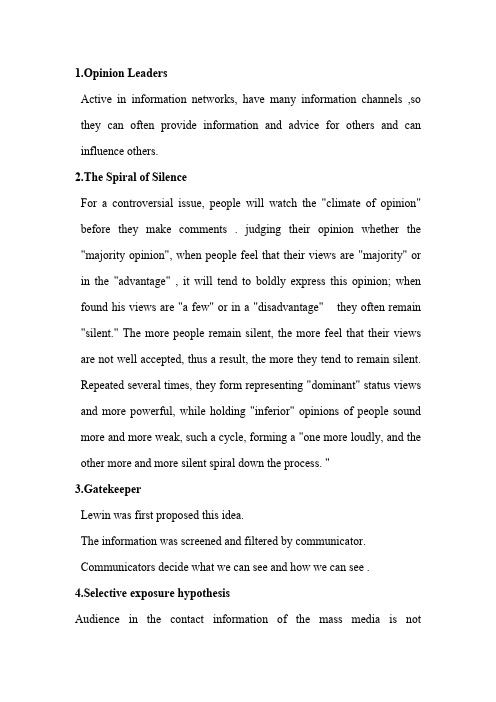
1.Opinion LeadersActive in information networks, have many information channels ,so they can often provide information and advice for others and can influence others.2.The Spiral of SilenceFor a controversial issue, people will watch the "climate of opinion" before they make comments . judging their opinion whether the "majority opinion", when people feel that their views are "majority" or in the "advantage" , it will tend to boldly express this opinion; when found his views are "a few" or in a "disadvantage" they often remain "silent." The more people remain silent, the more feel that their views are not well accepted, thus a result, the more they tend to remain silent. Repeated several times, they form representing "dominant" status views and more powerful, while holding "inferior" opinions of people sound more and more weak, such a cycle, forming a "one more loudly, and the other more and more silent spiral down the process. "3.GatekeeperLewin was first proposed this idea.The information was screened and filtered by communicator. Communicators decide what we can see and how we can see .4.Selective exposure hypothesisAudience in the contact information of the mass media is notindiscriminate, but more willing to choose the contents that are the same or similar to their opinion, and for the contents of this confrontation or conflict, there is a tendency to avoid.5.Knowledge Gap TheoryBecause the people who have higher economic status is usually much faster to get information than those of low socioeconomic status, therefore, the more information is transmitted by the mass media , the knowledge gap between the two types of people is more tend to expand.6.Agenda Setting TheoryMass media report an issue or not directly affect people's perception on the subject.Mass media highlights an issue will cause people to pay more attention to the issue.Mass media on a range of topics give different levels of coverage according to a certain order of priority, it will affect people’s judgment about importance of these issues .7.Magic bullet theoryThe message sent by the mass media is like a magic bullet, but the audience as the target without protection ,so the audience can easily be knocked down by the message sent by the mass media.The theory is that mass media have powerful force which can directly affect audience.Text One An Introduction to Communicationii) Key Words & Expressions:communication n. 传播journalism n. 新闻学transfer n.& v. 传递,迁移information n. 信息circulation n. 流通,运行,循环,传播convey v. 传送,传递feedback n. 反馈,反应medium n. 媒体,媒介,中介II. Text StudySTUDY PREVIEW communication is an important word in our today’s academic study in journalism, sociology, psychology, economics & politics. It’s also heard more & more often in our daily life. So what is communication?Communication:The transfer of social information & the circulation of social information systems.Social:When we say “communication” in our study, we usually mean human communication, not animal communication; a “communication” happening in a society, not in other environments such as natural, physical or biological ones.Why we study “human communication”?Communication is the tool that makes societies possible. It is no accident that communication and community have the same word root.Without communication, there would be no communities; and without community, there could be no communication.The sociologist Charles Cooley called communication “the mechanism through which human relations exist and develop_ all the symbols of the mind, together with the means of conveying them through space and preserving them in time”.Transfer of information:When “communication” happens, information flows from one person to another, and then the receiver may give some feedback to the giver. During this process, the information is shared, and the giver and receiver can play the opposite role.Also, communication needs some medium, which is something both parts of a communication can understand. For example, two or more people come together, trying to share some information. But they are from different countries and have different life experiences. So if they want to understand one another, they must use some medium such as English language, or even body language.In modern times, words are important tools or media for communication. But communication is not conducted entirely, or even mostly, in words. A gesture, a facial expression, a pitch pattern, a level of loudness, an emphasis, a kiss, a hand on the shoulder, a haircut or lack of one _ all these carry information.Text Two Types of Communicationii) Key Words & Expressions:mass media 大众传播媒体mass communication 大众传播intrapersonal communication 自我传播interpersonal communication 人际传播group communication 群体传播audience 受众,观众,听众encode 编码code 代码transmit 传输,传达,传播decode 解码internalize 使内在化II. Text StudySTUDY PREVIEW The communication in which the mass media engage is only one form of communication. One way to begin understanding the process of mass communication is to differentiate it from other forms of communication.Intrapersonal CommunicationWe engage in intrapersonal communication when we talk to ourselves to develop our thoughts and ideas. This intrapersonal communication precedes our speaking or acting.Intrapersonal communication is an exchange of information we have with ourselves, such as when we think over our next move in a video game or sing to ourselves in the shower. Typing into a computer is electronically mediated intrapersonal communication.Interpersonal CommunicationWhen people talk to each other, they are engaging in interpersonal communication. In this simplest form, interpersonal communication is between two people physically located in the same place. It can occur, however, if they are physically separated but emotionally connected, like lovers on cell phones.The difference between the prefixes intra- and inter- is the key difference between intrapersonal and interpersonal communication. Just as intrasquad athletic games are within a team, intrapersonal communication is within one’s self. Just as intercollegiate games are between schools, interpersonal communication is between individuals.Interpersonal communication includes exchanges in which two or more people take part, but the term is usually reserved for situations in which just two people are communicating. Having a face-to-face conversation over lunch and writing a letter to a friend are everyday examples. When interpersonal communication is electronically mediated, as in a telephone conversation, the term point-to-point communication is sometimes used.Group CommunicationThere comes a point when the number of people involved reduces the intimacy of the communication process. That’s when the situation becomes group communication. A club meeting is an example. So is a speech to an audience in an auditorium.Mass CommunicationCapable of reaching thousands, even millions, of people is mass communication, which is accomplished through a mass medium like television or newspapers. Mass communication can be defined as the process of using a mass medium to send messages to large audiences for the purpose of informing, entertaining or persuading.In many respects the process of mass communication and other communication forms is the same: Someone conceives a message, essentially an intrapersonal act. The message then is encoded into a common code, such as language. Then it’s transmitted. Another person receives the message, decodes it and internalizes it. Internalizing a message is also an intrapersonal act.In other respects, mass communication is distinctive. Crafting an effective message for thousands of people of diverse backgrounds and interests requires different skills than chatting with a friend across the table. Encoding the message is more complex because a device is always used-for example, a printing press, a camera or a recorder.One aspect of mass communication that should not be a mystery is the spelling of the often-misused word communication. The word takes no “s” if you are using it to refer to a process. If you are referring to a communication as a thing, such as a letter, a movie, a telegram or a television program, rather than a process, the word is communication insingular form and communication in plural. When the term mass communication refers to a process, it is spelled without the “s”.Review:communication: Exchange of ideas,information.intrapersonal Communication: Talking to oneself.interpersonal Communication: Usually two people face to face.group Communication: More than two people; in person.mass Communication: Many recipients; not face to face; a process.Text Three Components of Mass CommunicationSTUDY PREVIEW Mass communication is the process that mass communicators use to send their mass messages to mass audiences. They do this through the mass media. Think of these as the Five Ms: mass communicators, mass messages, mass media, mass communication and mass audience.Mass CommunicatorsThe heart of mass communication is the people who produce the messages that are carried in the mass media. These people include journalists, scriptwriters, lyricists, television anchors, radio disc jockeys, public relations practitioners and advertising copywriters. The list could go on and on.Mass communicators are unlike other communicators because they cannot see their audience. David Letterman knows that hundreds of thousands of people are watching as he unveils his latest Top 10 list, but he can’t see them or hear them chuckle and laugh. He receives no immediate feedback from his mass audience. This communicating with an unseen audience distinguishes mass communication from other forms of communication. Storytellers of yore told their vocabulary according to how they sensed they were being received. Mass communicators don’t have that advantage, although a studio audience.Mass MessagesA news item is a mass message, as are a movie, a novel, a recorded song and a billboard advertisement. The message is the most apparent part of our relationship to the mass media. It is for the messages that we pay attention to the media. We don’t listen to the radio, for example, to marvel at the technology. We listen to hear the music.Mass MediaThe mass media are the vehicles that carry messages. The primary mass media are books, magazines, newspapers, television, radio, sound recordings, movies and the web. Most theories view media as neutral carriers of messages. The people who are experts at media include technicians who keep the presses running and who keep the television transmitters on the air. Media experts also are tinkers and inventors whocome up with technical improvements, such as compact discs, DVDs, AM stereo radio and newspaper presses that can produce high-quality color.Mass CommunicationThe process through which messages reach the audience via the mass media is called mass communication. This is a mysterious process about which we know far less than we should. Researchers and scholars have unraveled some of the mystery, but most of how it works remains a matters of wonderment. For example, why do people pay more attention to some messages than to others? How does one advertisement generate more sales than another? Is behavior, including violent behavior, triggered through the mass communication process? There is reason to believe that mass communication affects voting behavior, but how does this work? Which is most correct-to say that people can be controlled by mass communication? Or manipulated? Or merely influenced? Nobody has the answer.Mass AudiencesThe size and diversity of mass audiences add complexity to mass communication. Only indirectly do mass communicators learn whether their messages have been received. Mass communicators are never sure exactly of the size of audiences, let alone of the effect of their messages. Mass audiences are fickle. What attracts great attention one day may notthe next. The challenge of trying to communicate to a mass audience is even more complex because people are tuning in and tuning out all the time, and when they are tuned in, it is with varying degrees of attentiveness.Review:mass Communicators: Message crafters.mass Message: What is communicated.mass Media: Vehicles that carry messages.mass Audiences: Recipients of mass messages.Text Four Communication Modelsii) Key Words & Expressions:communication model 传播模式narrative model 线性模式system model 系统模式the SMCR model 施拉姆模式concentric circle model 同心圆模式Claude Shannon 香农Warren Weaver 韦弗Harold Lasswell 拉斯韦尔Wilbur Schramm 施拉姆Thomas Bohn 波恩II. Text StudySTUDY PREVIEW Scholars have devised models of thecommunication process in an attempt to understand how the process works. Like all models, these are simplifications and are imperfect. Even so, these models bring some illumination to the mysterious communication process.Role of Communication ModelsHobbyists build models of ships, planes, automobiles and all kinds of other things. These models help them see whatever they are modeling in different ways. Industrial engineers and scientists do the same thing, learning lessons from models before they actually build something to full scale. Communication models are similar. By creating a facsimile of the process, we hope to better understand the process.A reality about models is that they are never perfect. This reality is especially true when the subject being modeled is complex. An architect, for example, may have a model of what the building will look like to passersby, but there also will be models of the building’s heating system, traffic patterns, and electrical, plumbing and ventilation systems. None of these models is complete or accurate in every detail, but all nonetheless are useful.Communication models are like that. Different models illustrate different aspects of the process. The process itself is so complex that no single model can adequately cover it.Basic ModelTwo Bell telephone engineers, Claude Shannon and Warren Weaver, laid out a basic communication model in 1948. They were working on advanced switching systems. The model, fundamentally a simple diagram, gave them a reference point for their work. That model has become a standard baseline for describing the communication process. The Shannon-Weaver model identifies five fundamental steps in the communication process:○The human stimulation that results in a thought.○The encoding of the thought into a message.○The transmission of the message.○The decoding of the message by the recipient into a thought.○The internalization of the message by the recipient.Narrative ModelYale professor Harold Lasswell, an early mass communication theorist, developed a useful yet simple model that was all words-no diagram. Lasswell’s narrative model poses four questions: Who says what? In which channel? To whom? With what effect?You can easily apply the model. Pick any bylined story from the front page of a newspaper.○Who says what? The newspaper reporter tells a story, often quoting someone who is especially knowledgeable4 on the subject.○In which channel? In this case the story is told through thenewspaper, a mass medium.○To whom? The story is told to a newspaper reader.○With what effect? The reader decides to vote for Candidate A or B, or perhaps readers just add the information to their reservoir of knowledge.The SMCR ModelThe classic model that stresses the dominance of the media was developed by Wilbur Schramm (1982), often credited as the founder of mass communication studies. He created what is known as the Source-Message-Channel-Receiver (SMCR) model.The Source-Message-Channel-Receiver(SMCR) model describes the exchange of information as the message passes from the source to the channel to the receiver, with feedback to the source.The source is the originator of the communication.The message is the content of the communication, the information that is to be exchanged.An encoder translates the message into a form that can be communicated-often a form that is not directly interpretable by human senses.A channel is the medium or transmission system used to convey the message from one place to another.A decoder reverses the encoding process.The receiver is the destination of the communication.A feedback mechanism between the source and the receiver regulates the flow of communication.Noise is any distortion or errors that may be introduced during the information exchange.This model can be applied to all forms of human communication, but here we will just illustrate it with mass communication examples. When you are at home watching a television program, the television network (a corporate source) originates the message, which is encoded by the microphones and television cameras in the television studio. The channel is not literally the number on the television dial to which you are tuned, but rather the entire chain of transmitters, satellite links, and cable television equipment required to convey the message to your home. Although we sometimes call a TV set a “receiver,” it is really the decoder and the viewer is the receiver. Feedback from viewers is via television rating services. Electronic interference with the broadcast and the distractions of barking dogs are possible noise components in this situation. The source of a message, which the author encoded with the software she used to compose the page’s content. The channel is the Internet, including the computer that the Web page is stored on, and the network connections between that computer, called a server, and your own. Your computer acts as the decoder. It decodes the message with your browser software (such as Netscape or Internet Explorer), and youare the receiver.In this classic view, mass communication is one-to-many communication, and the mass media are the various channels through which mass communication is delivered. That is, through newspapers, radio, TV, or film, the message is communicated from a single source to many receivers at about the same time, with limited opportunities for the audience to communicate back to the source.Concentric Circle ModelThe Shannon-Weaver model can be applied to all communication, but it misses some things that are unique to mass communication. In 1974 scholars Ray Hiebert, Donald Ungurait and Thomas Bohn presented an important new model-a series of concentric circles with the encoding source at the center. One of the outer rings was the receiving audience. In between were several elements that are important in the mass communication process but less so in other communication processes.The concentric circle model is one of the most complete models for identifying elements in the mass communication process, but it misses many complexities. It takes only one message from its point of origin, but in reality thousands of messages are being issued simultaneously. Audiences receive many of these messages, but not all of them, and the messages are received imperfectly. Feedback resonates back to communicators unevenly, often ill-based. Gatekeeping too is uneven. Inshort, there are so many variables that it is impossible to track what happens in any kind of comprehensive way.III.Review:Claude Shannon: Devised a basic communication model, with Warren Weaver.Warren Weaver: Devised a basic communication model, with Claude Shannon.basic communication model: Shows sender, encoding, transmission, decoding, receiver.Harold Lasswell: Devised the narrative model.narrative model: Describes process in words, not schematic.Thomas Bohn: Devised the concentric circle model, with Ray Hiebert, Donald Ungurait.concentric circle model: Useful radiating model of the mass communication process.Text Five Fundamentals in the Processii) Key Words & Expressions:homophyly n. 类似性tabloid n. 小报stimulation n. 刺激encoding n. 编码transmission n. 传递decoding n. 解码internalization n. 内化STUDY PREVIEW Most models for mass communication as well asother communication forms share some fundamental elements. The elements are sequential, beginning with whatever stimulates a person to want to communicate and continuing through encoding and transmission. To complete the communication process, the recipient of the message must decode and internalize it.StimulationBoth the Shannon-Weaver model and the concentric circle model begin with a source who is stimulated to want to communicate a message. The stimulation can result from many things. Emotions can be stimuli, as can something that is sensed. The stimulation can be as diverse as seeing a beautiful panorama or hearing a child cry.EncodingThe second step is encoding. The source puts thoughts into symbols that can be understood by whomever is destined to receive the message. The symbols take many forms-for example, the written word, smoke signals or pictographs.TransmissionThe message is the representation of the thought. In interpersonal communication the message is almost always delivered face to face. In mass communication, however, the message is encoded so that it is suitable for the equipment being used for transmission. Shannon and Weaver, being telephone engineers in the 1940s, offered the example ofthe sound pressure of a voice being changed into proportional electrical current for transmission over telephone lines. In technical terms, telephone lines were channels for Shannon and Weaver’s messages. On a more conceptual basis the telephone lines were the media, in the same way that the printed page or a broadcast signal is.DecodingThe receiver picks up signals sent by the transmitter. In interpersonal communication the receiver is a person who hears the message, sees it, or both. An angry message encoded as a fist banging a table is heard and perhaps felt. An insulting message encoded as a puff of cigar smoke in the face is smelled. In mass communication the first receiver of the message is not a person but the equipment that picks up and then reconstructs the message from the signal. This mechanical decoding is necessary so that the human receiver of the message can understand it. As Shannon and Weaver put it: “The receiver ordinarily performs the inverse operation that was done by the transmitter. ”InternalizationIn mass communication a second kind of decoding occurs with the person who receives the message from the receiving equipment. This is an intrapersonal act, internalizing the message. For this second kind of decoding to work, the receiver must understand the communication form chosen by the source in encoding. Someone who reads only English willnot be able to decode a message in Greek. Someone whose sensitivities are limited to punk rock will not understand Handel’s “Water Music.” In other words, the source and the receiver must have enough in common for communication to occur. This common experience, which can be as simple as speaking the same tongue, is called homophyly. In mass communication the encoder must know the audience well enough to shape messages that can be decode accurately and with the intended effect.The audience and how it perceives a message are essential in the mass communication process. This is no better illustrated than in a front-page headline in the National Examiner, a sensationalizing weekly tabloid: “Cops Think Kato Did It!” Brain “Kato” Kaelin was a pal of O. J. Simpson and had been subjected to police interviewing off and on for months before the Simpson murder trial. Kaelin sued the Examiner over the headline. In court, the Examiner said the “it” in the headline didn’t refer to the murders but to possible perjury. The Examiner argued that “it” was explained in a secondary head on Page 1: “…He Fears They Want Him for Perjury. ”A three-judge federal appeals court sided with Kaelin, saying that Examiner readers were likely to infer that the police thought he was a murder. This was despite the fact that the story made it clear that “it” was perjury, not murder, and also despite the secondary Page 1head.The judges noted that the headline came only a week after the widely reported Simpson acquittal and that, in the court’s opinion, people who had followed the trial reasonably could have interpreted “it” to be murder. The decision allowed Kaelin to pursue his $15 million legal action against the Examiner.For mass communicators the lesson is that strict, literal meanings are not always enough. Audience inferences, part of the intrapersonal decoding process, must also be considered.stimulation: Stirs someone to communicate.encoding: Putting something into symbols.transmission: Sending a message.decoding: Translating a symbolic message.internalization: Making sense of a decoded message.homophyly: A coding oneness that makes communication possible.。
传播学Communication术语中英文对照
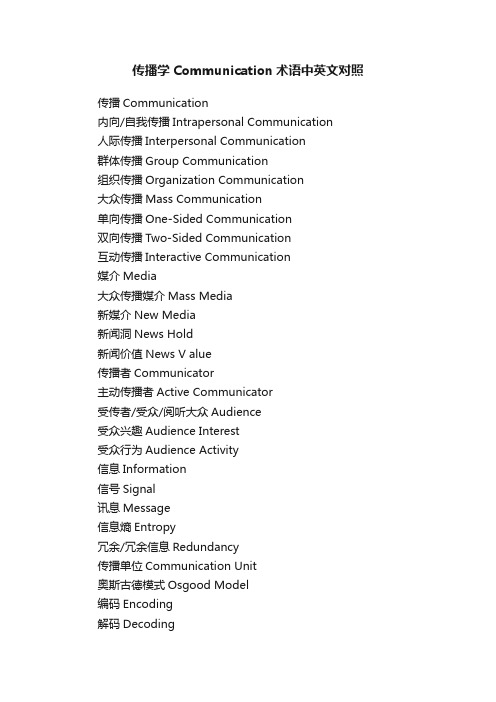
传播学Communication术语中英文对照传播Communication内向/自我传播Intrapersonal Communication人际传播Interpersonal Communication群体传播Group Communication组织传播Organization Communication大众传播Mass Communication单向传播One-Sided Communication双向传播Two-Sided Communication互动传播Interactive Communication媒介Media大众传播媒介Mass Media新媒介New Media新闻洞News Hold新闻价值News V alue传播者Communicator主动传播者Active Communicator受传者/受众/阅听大众Audience受众兴趣Audience Interest受众行为Audience Activity信息Information信号Signal讯息Message信息熵Entropy冗余/冗余信息Redundancy传播单位Communication Unit奥斯古德模式Osgood Model编码Encoding解码Decoding信源Source传播的数学理论Mathematical Theory of Communication 传播渠道Communication Channel有效传播Effective Communication传播效果Effects知识沟Knowledge-Gap使用与满足模式Uses and Gratifications Model使用与依从模式Uses and Dependencys Model口传系统System of Oral Communication地球村Global Village内爆Implosion全球化Globalization本土化Localization电子空间Cyber Space数字化Digitalization文化帝国主义Culture Imperialism跨文化传播Intercultural Communication 守门人Gatekeeper 新闻采集者News Gatherers新闻加工者News Processors模式Model有线效果模式Limited Effects Model适度效果模式Moderate Effects Model 强大效果模式Powerful Effects Model 子弹论Bullet Theory两级传播模式Two-Step Flow Model多级传播模式Multi-Step Flow Model沉默的螺旋模式Spiral of Silence Model 劝服传播Persuasive Communication议程设置模式the Agenda-Setting Model 时滞Time Lag最合适效果跨度Optimal Effects Pan时间跨度Time Span公众舆论Public Opinion选择性接触Selective Exposure 选择性注意Selective Attention 选择性理解Selective Perception 选择性记忆Selective Retention 可信性提示Credibility Heuristic 喜爱提示Liking Heuristic共识提示Consensus Heuristic。
传播学英语
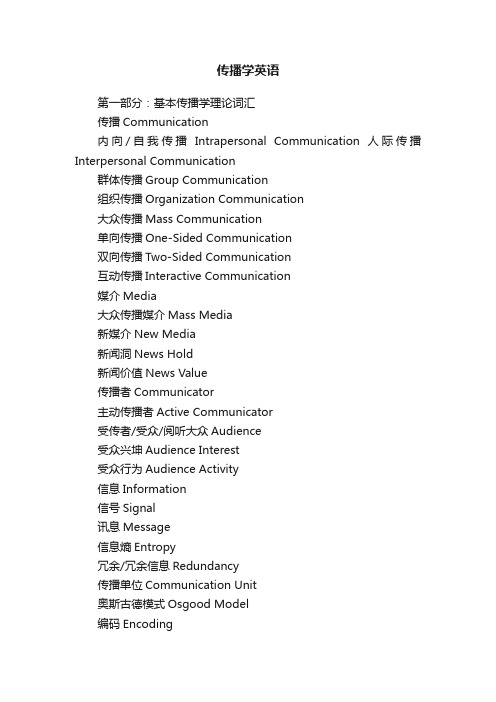
传播学英语第一部分:基本传播学理论词汇传播Communication内向/自我传播Intrapersonal Communication 人际传播Interpersonal Communication群体传播Group Communication组织传播Organization Communication大众传播Mass Communication单向传播One-Sided Communication双向传播Two-Sided Communication互动传播Interactive Communication媒介Media大众传播媒介Mass Media新媒介New Media新闻洞News Hold新闻价值News Value传播者Communicator主动传播者Active Communicator受传者/受众/阅听大众Audience受众兴坤Audience Interest受众行为Audience Activity信息Information信号Signal讯息Message信息熵Entropy冗余/冗余信息Redundancy传播单位Communication Unit奥斯古德模式Osgood Model编码Encoding解码Decoding信源Source传播的数学理论Mathematical Theory of Communication 传播渠道Communication Channel有效传播Effective Communication传播效果Effects知识沟Knowledge-Gap使用与满足模式Uses and Gratifications Model使用与依从模式Uses and Dependencys Model口传系统System of Oral Communication地球村Global Village内爆Implosion全球化Globalization本土化Localization电子空间Cyber Space数字化Digitalization文化帝国主义Culture Imperialism跨文化传播Intercultural Communication守门人Gatekeeper新闻采集者News Gatherers新闻加工者News Processors模式Model有线效果模式Limited Effects Model适度效果模式Moderate Effects Model强大效果模式Powerful Effects Model子弹论Bullet Theory两级传播模式Two-Step Flow Model多级传播模式Multi-Step Flow Model沉默的螺旋模式Spiral of Silence Model劝服传播Persuasive Communication议程设置模式the Agenda-Setting Model时滞Time Lag最合适效果跨度Optimal Effects Pan时间跨度Time Span公众舆论Public Opinion选择性接触Selective Exposure选择性注意Selective Attention选择性理解Selective Perception选择性记忆Selective Retention可信性提示Credibility Heuristic喜爱提示Liking Heuristic共识提示Consensus Heuristic市场驱动新闻学the Market-Driven Journalism 意识形态Ideology霸权Hegemony权力话语Power Discourse视觉文本Visual Text文本Text超级文本Hypertext结构主义Constructionism解构主义Deconstructionism文化工业Culture Industry大众文化Mass Culture文化研究Cultural Studies批判学派/批判理论Critical Theory法兰克福学派Frankfurt School女权主义/女性主义Feminism符号学Semiotics/Semiology符号Sign能指与所指Signified/Signifier非语言符号Nonverbal Sign非语言传播Nonverbal Communication 意指Signification话语理论Theories of Discourse文化期待Culture Expectations文化批判Culture Criticizing范式Paradigm叙事范式Narrative Paradigm强语境High Context弱语境Low Context功能理论Functionalism话语分析Discourse Analysis传播的商品形式the Commodity Forms of Communication 受众商品Audience Commodity商品化Commodification空间化Spatialization结构化Structuration媒介集中化Media Conglomeration传媒产业Media Industry注意力经济Attention Economy媒介竞争Media Competition受众分割Audience Segmentation媒介资本Media Capital传播政治经济学Political Economy of Communication传播研究Communication Research抽样Sampling调查研究方法Survey Research内容分析法Content Analysis实验分析法Experimental Research定性研究法Qualitative Research Methods个案研究法Case Study效度与信度Validity/Reliability变量Variables实地观察法Field Observation虚拟社群Virtual Community扩散研究Diffusion Research媒介事件Media Events民族志Ethnography传播生态Ecology of Communication 真实/虚构Reality/Fiction 拟态环境Pseudo-Environment刻板成见Stereotyping晕轮效应Halo Effects二元价值评判Two-Valued Evaluation 公共关系Public Relation 阐释理论Interpretive Theory第二部分:新闻采编相关词汇daily 日报morning edition 晨报evening edition 晚报quality paper 高级报纸popular paper 大众报纸evening paper 晚报government organ 官报part organ 党报trade paper 商界报纸vernacular paper 本国文报纸political news 政治报纸Newspaper Week 新闻周刊the front page 头版第一版bulldog edition 晨版article 记事headline 标题banner headline 头号大标题byline 标题下署名之行dateline 日期、发稿地之行big news 头条新闻hot news 最新新闻exclusive news 独家新闻scoop 特讯feature 特写花絮criticism 评论editorial 社论review comment 时评book review 书评topicality 时事问题city news 社会新闻column 栏letters 读者投书栏general news column 一槃消息栏cartoon comics 漫画weather forecast 天气预报serial story 新闻小说obituary notice 讣闻public notice 公告advertisement 广告calssified ad 分类广告flash-news 大新闻extra 号外the sports page 运动栏literary criticism 文艺评论Sunday features 周日特刊newsbeat 记者采访地区news blackout 新闻管制press ban 禁止刊行yellow sheet 低俗新闻tabloid 图片版新闻"Braille" edition 点字版newspaper office 报社publisher 发行人proprieter 社长bureau chief copy chief 总编辑editor-in-chief 总主笔editor 编辑主笔newsman newspaperman journalist 新闻记者cub reporter 初任记者reporter 采访记者war correspondent campaign badge 随军记者columnist 专栏记者star reporter 一流通讯员correspondent 通讯员special correspondent 特派员contributor 投稿家news source 新闻来源informed sources 消息来源newspaper campaign 新闻战free-lancer writer 自由招待会press box 记者席news conference press conference 记者招待会International Press Association 国际新闻协会distribution 发行circulation 发行份数newsstand kiosk 报摊newspaper agency 报纸代售处newsboy 报童subscription (rate) 报费newsprint 新闻用纸Fleet Street 舰队街accredited journalist n. 特派记者advertisement n.广告.advance n.预发消息;预写消息affair n.桃色新闻;绯闻anecdote n.趣闻轶事assignment n.采写任务attribution n. 消息出处,消息来源back alley news 小道消息backgrounding 新闻背景Bad news travels quickly. 坏事传千里。
传播学复习资料
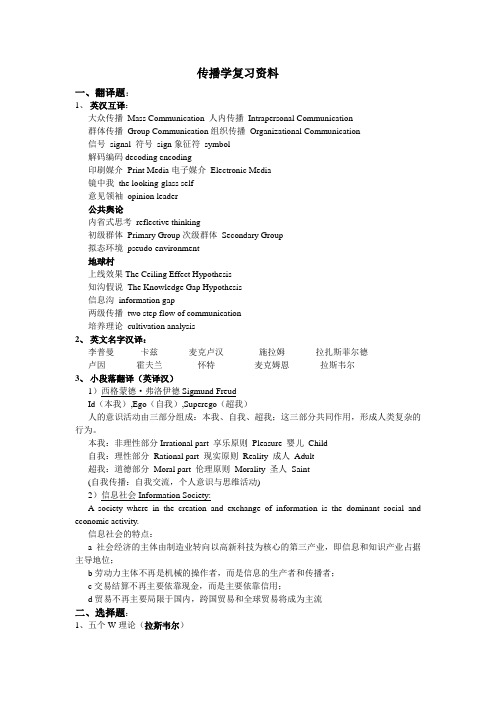
传播学复习资料一、翻译题:1、英汉互译:大众传播Mass Communication 人内传播Intrapersonal Communication群体传播Group Communication组织传播Organizational Communication信号signal 符号sign象征符symbol解码编码decoding encoding印刷媒介Print Media电子媒介Electronic Media镜中我the looking-glass self意见领袖opinion leader公共舆论内省式思考reflective thinking初级群体Primary Group次级群体Secondary Group拟态环境pseudo-environment地球村上线效果The Ceiling Effect Hypothesis知沟假说The Knowledge Gap Hypothesis信息沟information gap两级传播two step flow of communication培养理论cultivation analysis2、英文名字汉译:李普曼卡兹麦克卢汉施拉姆拉扎斯菲尔德卢因霍夫兰怀特麦克姆恩拉斯韦尔3、小段落翻译(英译汉)1)西格蒙德·弗洛伊德Sigmund FreudId(本我),Ego(自我),Superego(超我)人的意识活动由三部分组成:本我、自我、超我;这三部分共同作用,形成人类复杂的行为。
本我:非理性部分Irrational part 享乐原则Pleasure 婴儿Child自我:理性部分Rational part 现实原则Reality 成人Adult超我:道德部分Moral part 伦理原则Morality 圣人Saint(自我传播:自我交流,个人意识与思维活动)2)信息社会Information Society:A society where in the creation and exchange of information is the dominant social and economic activity.信息社会的特点:a社会经济的主体由制造业转向以高新科技为核心的第三产业,即信息和知识产业占据主导地位;b劳动力主体不再是机械的操作者,而是信息的生产者和传播者;c交易结算不再主要依靠现金,而是主要依靠信用;d贸易不再主要局限于国内,跨国贸易和全球贸易将成为主流二、选择题:1、五个W理论(拉斯韦尔)2、把关理论(库尔特·卢因最早提出;怀特将其引入新闻研究领域)3、广播领域的使用与满足理论是谁提出的(H.赫卓格)4、媒介即讯息(麦克卢汉)5、沉默的螺旋理论是谁提出的(诺依曼)三、简答题:1、传播模式1)Classical Communication Model亚里士多德Aristotle’s Model of Communication:Five factors:speaker speech audience effect occasionSpeaker-centered,speech occasionStress the effect of persuasion2)Early Linear Model of Communication Process拉斯韦尔模式香农-韦弗模式施拉姆模式3)Circular Communication Model4) Non-linear Models丹斯的直线上升螺旋模式5)Social System Model赖利夫妇的传播系统模式The Riley’s Model of Social System,1959马莱兹克关于大众传播过程的系统模式Maletzke’s Model of The Mass Media 2、麦克卢汉观点媒介:人的延伸Understanding Media:The Extensions of Man媒介即讯息The Medium is the Message“热媒介”与“冷媒介”Cool Media Hot Media3、大众传播功能说(拉斯韦尔三功能说、赖特、拉扎斯菲尔德)1)拉斯韦尔的“三功能说”:环境监测功能Surveillance of the environment社会协调功能Correlation社会遗产传承功能Transmission of culture2)赖特的“四功能说”:环境监视Surveillance解释与规定Persuation社会化功能Socialization提供娱乐Entertainment3)拉扎斯菲尔德和默顿的功能观:社会地位赋予功能社会规范强制功能作为负面功能的“麻醉作用”四、Discussion1、把关、议程设置举例说明2、知沟理论五、根据英文材料改写成中文新闻(200-250字)。
传播学术语中英对照

人内传播:intra-personal communication 自我互动:self interaction象征符:symbol内省式思考:reflective thinking人际传播:personal communication集合行为:collective behavior乌合之众:crowd流言:rumor意见领袖:opinion leader两级传播:two step flow of communication 中介因素:mediating factors信息流:information flow影响流:influencing flow知沟:knowledge gap数字鸿沟:digital gap可信性:credibility专业权威性:expertness休眠效果(霍夫兰):sleeper effect诉诸理性:rational persuasion诉诸情感:emotional persuasion显著性:salience自信心假说:self-confidence hypothesis议程设置功能:the agenda-setting function:McCombs&Show What is the agenda-setting function:Media concentration on a few issues and subjects leads the public to perceive those issues as more important than other issues. That is,if a news item is covered frequently and prominently,the audience will regard the issue as more important.属性议程设置:attributes agenda-setting沉默的螺旋:the spiral of silence社会合意:social consensus意见气候:opinion climate中坚分子:the hard core培养分析:cultivation analysis故事讲解员:story-teller熔炉:melting-pot新闻框架:news frameNews frame的四种功能:Problem definition(提供问题定义);causal interpretation(阐释事件原因);moral evaluation(提供道德评价);treatment recommendation(示意解决方案)上限效果(ceiling effect)假说;信息富有者(information-rich)信息贫困者(information-poor)媒介素养(media literacy)第三人效果(the third-person effect)拉斯韦尔:Lasswell卢因:Lewin霍夫兰:Hovland拉扎斯菲尔德:Lazarsfeld施拉姆:Schramm香农:Shannon威纳:Norbert Wiener经验学派:empirical school批判学派:critical school霸权:hegemony文化帝国主义:cultural imperialism文本解析:text analysis美国源流:杜威(Dewey)库利(Cooley)提出两个概念:一是初级群体(primary group)二是镜中我(looking-glass self)帕克(Park)米德(Mead):主我(I)和客我(Me)对理解人内传播很有意义李普曼(Lippmann)拟态环境(pseudo-environment)刻板成见(stereotype)拉斯韦尔三功能说:环境监视功能(surveillance of the environment)社会联系与协调功能(correlation of the parts of society)社会遗产传承功能(transmission of social heritage)拉扎斯菲尔德三功能:社会地位赋予功能(status conferral)社会规范强制功能(enforcement of social norms)作为负面功能的“麻醉功能”(narcotizing dysfunction)电子乌托邦(teletopia)多媒体(multi-media)传播制度几种规范理论:集权主义authoritarianism受众权利:传播权(the right to communicate)知晓权(the right to know)媒介接近权(the right of access to mass media)acredited journalist n.特派记者advertisment n.广告advance n.预发消息;预写消息affair(e)n.桃色新闻;绯闻anecdote n.趣闻轶事assignment n.采写任务attribution n.消息出处,消息来源back alley news n.小道消息backgrounding n.新闻背景Bad news travels quickly.坏事传千里。
麦奎尔传播规范理论中英文翻译
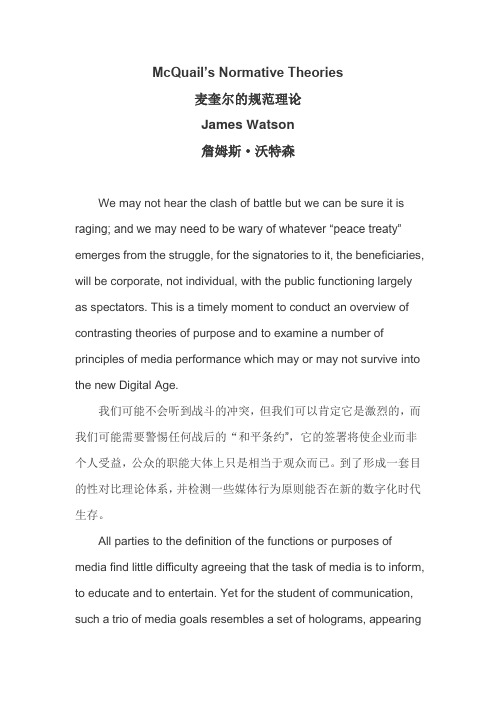
McQuail’s Normative Theories麦奎尔的规范理论James Watson詹姆斯·沃特森We may not hear the clash of battle but we can be sure it is raging; and we may need to be wary of whatever “peace treaty” emerges from the struggle, for the signatories to it, the beneficiaries, will be corporate, not individual, with the public functioning largely as spectators. This is a timely moment to conduct an overview of contrasting theories of purpose and to examine a number of principles of media performance which may or may not survive into the new Digital Age.我们可能不会听到战斗的冲突,但我们可以肯定它是激烈的,而我们可能需要警惕任何战后的“和平条约”,它的签署将使企业而非个人受益,公众的职能大体上只是相当于观众而已。
到了形成一套目的性对比理论体系,并检测一些媒体行为原则能否在新的数字化时代生存。
All parties to the definition of the functions or purposes of media find little difficulty agreeing that the task of media is to inform, to educate and to entertain. Yet for the student of communication, such a trio of media goals resembles a set of holograms, appearingto have substance and meaning but reaching out to them only locates thin air. Information, yes—but what information; education, yes—but what do we mean by education; entertainment, certainly—but does it s separate classification mean that it cannot also be informative and educational or that information and education cannot be entertaining? Several commentators, best known among them Denis McQuail, have sought to create a more complex taxonomy of purposes as they operate in varying contexts.功能或作用各异的所有媒介几乎都同意媒介的任务是告知,教育和娱乐。
传播学英文教材

传播学英文教材
以下是一些常见的传播学英文教材:
1. 《Communication Theory》:这本书由美国传播学者Barry Wells撰写,介绍了传播学的各种理论,包括符号学、修辞学、社会学和心理学等。
2. 《The Elements of Style》:这本书由美国著名作家和编辑William Strunk Jr.撰写,是英文写作的经典教材。
它详细介绍了如何使用简单、清
晰的语言来写作,包括如何选择词汇、组织句子和段落等。
3. 《The Media and Modern Society》:这本书由美国传播学者Marshall McLuhan撰写,探讨了媒体在现代社会中的作用和影响。
它分析了电视、广播、报纸和杂志等各种媒体的特点和作用,并探讨了媒体对文化、政治和经济等方面的影响。
4. 《Mass Communication》:这本书由美国传播学者James Katz撰写,是传播学专业的基础教材之一。
它介绍了大众传播的概念、历史和理论,并探讨了各种媒体(如电视、广播和报纸)的传播特点和影响。
5. 《Media and Society》:这本书由英国传播学者John Downing撰写,是媒体与社会关系方面的经典教材。
它探讨了媒体在社会中的作用和影响,并分析了媒体如何塑造人们对世界的认知和态度。
这些教材都是传播学领域的经典之作,有助于学生深入了解传播学的理论和实践。
当然,还有其他优秀的传播学教材可供选择,建议根据自己的兴趣和需求选择适合自己的教材。
传播学经典理论英文版
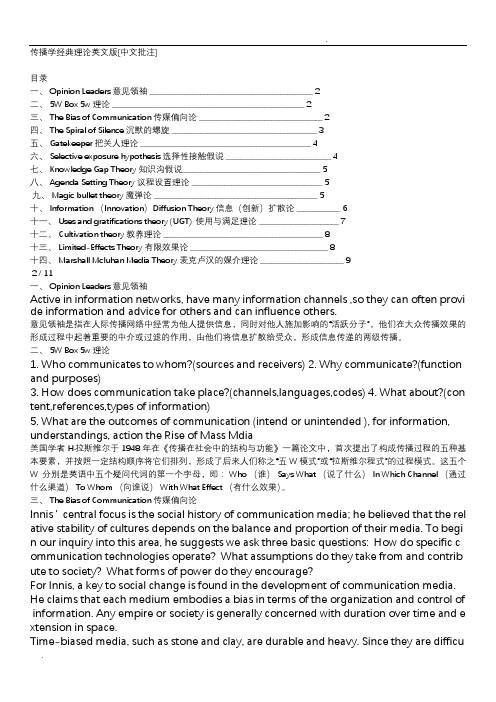
传播学经典理论英文版[中文批注]目录一、Opinion Leaders意见领袖_____________________________________________2二、5W Box5w理论_____________________________________________________2三、The Bias of Communication传媒偏向论__________________________________2四、The Spiral of Silence沉默的螺旋________________________________________3五、Gatekeeper把关人理论_______________________________________________4六、Selective exposure hypothesis选择性接触假说_____________________________4七、Knowledge Gap Theory知识沟假说______________________________________5八、Agenda Setting Theory议程设置理论____________________________________5九、Magic bullet theory魔弹论_____________________________________________5十、Information(Innovation)Diffusion Theory信息(创新)扩散论____________6十一、Uses and gratifications theory(UGT)使用与满足理论______________________7十二、Cultivation theory教养理论____________________________________________8十三、Limited-Effects Theory有限效果论______________________________________8十四、Marshall Mcluhan Media Theory麦克卢汉的媒介理论_______________________92/11一、Opinion Leaders意见领袖Active in information networks,have many information channels,so they can often provi de information and advice for others and can influence others.意见领袖是指在人际传播网络中经常为他人提供信息,同时对他人施加影响的“活跃分子”,他们在大众传播效果的形成过程中起着重要的中介或过滤的作用,由他们将信息扩散给受众,形成信息传递的两级传播。
传播学专业英语教程
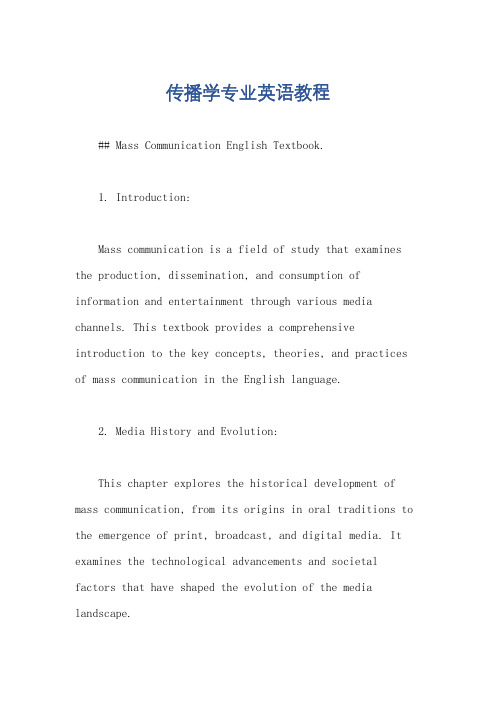
传播学专业英语教程## Mass Communication English Textbook.1. Introduction:Mass communication is a field of study that examines the production, dissemination, and consumption of information and entertainment through various media channels. This textbook provides a comprehensive introduction to the key concepts, theories, and practices of mass communication in the English language.2. Media History and Evolution:This chapter explores the historical development of mass communication, from its origins in oral traditions to the emergence of print, broadcast, and digital media. It examines the technological advancements and societal factors that have shaped the evolution of the media landscape.3. Media Theories and Models:This chapter introduces various theoretical frameworks and models that seek to explain the functions, effects, and implications of mass communication. It covers theories such as agenda-setting, framing, and cultivation, among others.4. Media Production and Programming:This chapter discusses the processes involved in media production, from content creation to distribution and consumption. It examines different media formats, genres, and programming strategies, as well as the ethical considerations and regulatory frameworks governing media production.5. Media and Society:This chapter explores the complex relationship between media and society. It examines the role of media in shaping public opinion, facilitating social change, and promotingsocial cohesion or division.6. Digital Media and the Internet:This chapter focuses on the transformative impact of digital technologies on mass communication. It discussesthe rise of social media, the internet as a platform for news and information dissemination, and the challenges and opportunities posed by digitalization.7. Global Media and Communication:This chapter examines the globalization of media and communication. It explores cross-cultural media consumption, the flow of information across borders, and theimplications for global understanding and communication.8. Media and Law:This chapter addresses the legal and ethical issues surrounding mass communication. It covers topics such as freedom of speech, libel, intellectual property, and theregulation of media content.9. Media Literacy and Criticism:This chapter emphasizes the importance of medialiteracy and critical thinking skills. It provides toolsand techniques for analyzing media messages, evaluatingtheir credibility, and understanding their potential impact.10. Future of Mass Communication:This final chapter explores the challenges and opportunities facing the field of mass communication in the 21st century. It examines the convergence of media, therise of artificial intelligence, and the evolving role of media in a rapidly changing world.中文回答:1. 导言:传播学是一门研究信息和娱乐通过各种媒体渠道的制作、传播和消费的学科。
传播学经典理论英文版打印1
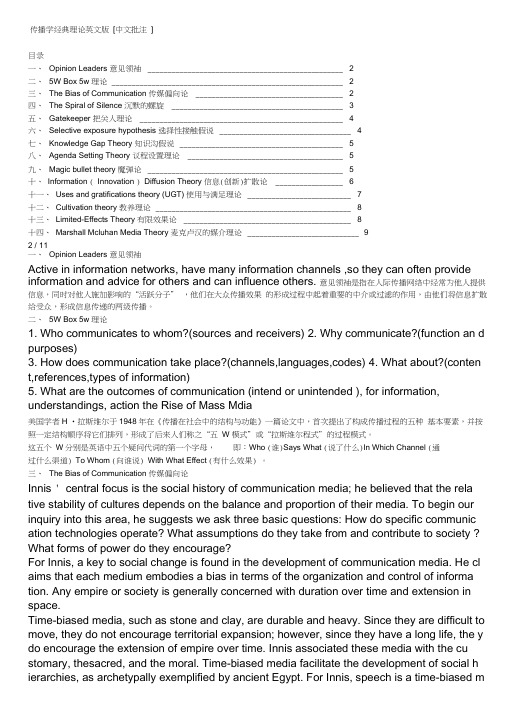
传播学经典理论英文版[中文批注]目录一、Opinion Leaders 意见领袖_________________________________________________ 2二、5W Box 5w 理论__________________________________________________________ 2三、The Bias of Communication 传媒偏向论 _____________________________________ 2四、The Spiral of Silence 沉默的螺旋 ___________________________________________ 3五、Gatekeeper 把关人理论 ___________________________________________________ 4六、Selective exposure hypothesis 选择性接触假说_________________________________ 4七、Knowledge Gap Theory 知识沟假说_________________________________________ 5八、Agenda Setting Theory 议程设置理论 _______________________________________ 5九、Magic bullet theory 魔弹论_________________________________________________ 5十、Information ( Innovation ) Diffusion Theory 信息(创新)扩散论 _________________ 6十一、Uses and gratifications theory (UGT) 使用与满足理论__________________________ 7十二、Cultivation theory 教养理论_________________________________________________ 8十三、Limited-Effects Theory 有限效果论__________________________________________ 8十四、Marshall Mcluhan Media Theory 麦克卢汉的媒介理论____________________________ 92 / 11一、Opinion Leaders 意见领袖Active in information networks, have many information channels ,so they can often provide information and advice for others and can influence others. 意见领袖是指在人际传播网络中经常为他人提供信息,同时对他人施加影响的“活跃分子” ,他们在大众传播效果的形成过程中起着重要的中介或过滤的作用,由他们将信息扩散给受众,形成信息传递的两级传播。
传播学 Communication 术语中英文对照
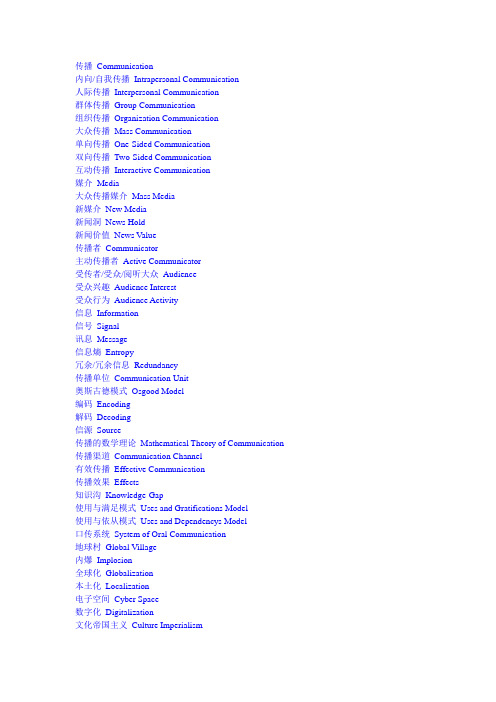
传播Communication内向/自我传播Intrapersonal Communication人际传播Interpersonal Communication群体传播Group Communication组织传播Organization Communication大众传播Mass Communication单向传播One-Sided Communication双向传播Two-Sided Communication互动传播Interactive Communication媒介Media大众传播媒介Mass Media新媒介New Media新闻洞News Hold新闻价值News Value传播者Communicator主动传播者Active Communicator受传者/受众/阅听大众Audience受众兴趣Audience Interest受众行为Audience Activity信息Information信号Signal讯息Message信息熵Entropy冗余/冗余信息Redundancy传播单位Communication Unit奥斯古德模式Osgood Model编码Encoding解码Decoding信源Source传播的数学理论Mathematical Theory of Communication 传播渠道Communication Channel有效传播Effective Communication传播效果Effects知识沟Knowledge-Gap使用与满足模式Uses and Gratifications Model使用与依从模式Uses and Dependencys Model口传系统System of Oral Communication地球村Global Village内爆Implosion全球化Globalization本土化Localization电子空间Cyber Space数字化Digitalization文化帝国主义Culture Imperialism跨文化传播Intercultural Communication 守门人Gatekeeper新闻采集者News Gatherers新闻加工者News Processors模式Model有线效果模式Limited Effects Model适度效果模式Moderate Effects Model 强大效果模式Powerful Effects Model 子弹论Bullet Theory两级传播模式Two-Step Flow Model多级传播模式Multi-Step Flow Model沉默的螺旋模式Spiral of Silence Model 劝服传播Persuasive Communication议程设置模式the Agenda-Setting Model 时滞Time Lag最合适效果跨度Optimal Effects Pan时间跨度Time Span公众舆论Public Opinion选择性接触Selective Exposure选择性注意Selective Attention选择性理解Selective Perception选择性记忆Selective Retention可信性提示Credibility Heuristic喜爱提示Liking Heuristic共识提示Consensus Heuristic。
- 1、下载文档前请自行甄别文档内容的完整性,平台不提供额外的编辑、内容补充、找答案等附加服务。
- 2、"仅部分预览"的文档,不可在线预览部分如存在完整性等问题,可反馈申请退款(可完整预览的文档不适用该条件!)。
- 3、如文档侵犯您的权益,请联系客服反馈,我们会尽快为您处理(人工客服工作时间:9:00-18:30)。
传播学经典理论英文版[中文批注]目录一、 Opinion Leaders 意见领袖 _____________________________________________ 2二、 5W Box 5w 理论 _____________________________________________________ 2三、 The Bias of Communication 传媒偏向论 __________________________________ 2四、 The Spiral of Silence 沉默的螺旋 ________________________________________ 3五、 Gatekeeper 把关人理论 _______________________________________________ 4六、 Selective exposure hypothesis 选择性接触假说 _____________________________ 4七、 Knowledge Gap Theory 知识沟假说______________________________________ 5八、 Agenda Setting Theory 议程设置理论 ____________________________________ 5九、 Magic bullet theory 魔弹论 _____________________________________________ 5十、 Information (Innovation)Diffusion Theory 信息(创新)扩散论 ____________ 6十一、 Uses and gratifications theory (UGT) 使用与满足理论 ______________________ 7十二、 Cultivation theory 教养理论 ____________________________________________ 8十三、 Limited-Effects Theory 有限效果论 ______________________________________ 8十四、 Marshall Mcluhan Media Theory 麦克卢汉的媒介理论 _______________________ 92 / 11一、 Opinion Leaders 意见领袖Active in information networks, have many information channels ,so they can often provide information and advice for others and can influence others.意见领袖是指在人际传播网络中经常为他人提供信息,同时对他人施加影响的“活跃分子”,他们在大众传播效果的形成过程中起着重要的中介或过滤的作用,由他们将信息扩散给受众,形成信息传递的两级传播。
二、 5W Box 5w 理论1. Who communicates to whom?(sources and receivers)2. Why communicate?(function and purposes)3. How does communication take place?(channels,languages,codes)4. What about?(content ,references,types of information)5. What are the outcomes of communication (intend or unintended ), for information, understandings, action the Rise of Mass Mdia美国学者H·拉斯维尔于1948年在《传播在社会中的结构与功能》一篇论文中,首次提出了构成传播过程的五种基本要素,并按照一定结构顺序将它们排列,形成了后来人们称之“五W模式”或“拉斯维尔程式”的过程模式。
这五个W分别是英语中五个疑问代词的第一个字母,即: Who (谁) Says What (说了什么) In Which Channel (通过什么渠道) To Whom (向谁说) With What Effect (有什么效果)。
三、 The Bias of Communication 传媒偏向论Innis’ central focus is the social history of communication media; he believed that the relat ive stability of cultures depends on the balance and proportion of their media. To begin our inquiry into this area, he suggests we ask three basic questions: How do specific communic ation technologies operate? What assumptions do they take from and contribute to society ? What forms of power do they encourage?For Innis, a key to social change is found in the development of communication media. He cl aims that each medium embodies a bias in terms of the organization and control of informat ion. Any empire or society is generally concerned with duration over time and extension in s pace.Time-biased media, such as stone and clay, are durable and heavy. Since they are difficult to move, they do not encourage territorial expansion; however, since they have a long life, the y do encourage the extension of empire over time. Innis associated these media with the cu stomary, thesacred, and the moral. Time-biased media facilitate the development of social h ierarchies, as archetypally exemplified by ancient Egypt. For Innis, speech is a time-biased m edium.Space-biased media are light and portable; they can be transported over large distances. Th ey are associated with secular and territorial societies; they facilitate the expansion of empir e over space. Paper is such a medium; it is readily transported, but has a relatively short lifes pan.伊尼斯发现,媒介可以分为两大类,两者有一个基本的区别:有利于空间上延伸的媒介和有利于时间上延续的媒介。
比如,石版文字和泥版文字耐久,它们承载的文字具有永恒的性质,容易传承。
但是,它们不容易运输,不容易生产,不容易使用,因而不利于空间上的传播。
相反,莎草纸和纸张轻巧,容易运输,使用方便,能够远距离传播迅息,然而它们传播的迅息却限于当下,就比较短暂。
他认为,传播和传播媒介都有偏向,大体上分为:口头传播的偏向与书面传播的偏向,时间的偏向与空间的偏向。
下面这段话,痛快淋漓地阐明伊尼斯“传播偏向论”的意旨、要害,说明媒介的性质和偏向,并且说明媒介为何有这些偏向。
他说:“倚重时间的媒介,其性质耐久,羊皮纸、黏土和石头即为其例……倚重空间的媒介,耐久性比较逊色,质地比较轻。
后者适合广袤地区的治理和贸易……倚重空间的材料,有利于集中化……我们考虑大规模的政治组织,比如帝国时,必须立足在空间和时间两个方面。
我们要克服媒介的偏向,既不过分倚重时间,也不过分倚重空间。
”强调媒介偏向、时间偏向和空间偏向的关系,并指出媒介与国家僚体制和宗教的关系。
他说:“一个成功的帝国必须充分认识到空间问题,空间问题既是军事问题,也是政治问题;它还要认识到时间问题,时间问题既是朝代问题和人生寿限问题,也是宗教问题。
又说:“国家的官僚体制倚重空间,忽略时间。
相反,宗教却倚重时间,忽略空间。
”四、 The Spiral of Silence 沉默的螺旋T he spiral of silence is a political science and mass communication theory propounded by th e German political scientist Elisabeth Noelle-Neumann. Spiral of silence theory describes th e process by which one opinion becomes dominant as those who perceive their opinion to b e in the minority do not speak up because society threatens individuals with fear of isolatio n. The assessment of one's social environment may not always correlate with reality.For a controversial issue, people will watch the "climate of opinion" before they make com ments . judging their opinion whether the "majority opinion", when people feel that their vi ews are "majority" or in the "advantage" , it will tend to boldly express this opinion; when fo und his views are "a few" or in a "disadvantage" they often remain "silent." The more peopl e remain silent, the more feel that their views are not well accepted, thus a result, the more they tend to remain silent.Repeated several times, they form representing "dominant" status views and more powerful , while holding "inferior" opinions of people sound more and more weak, such a cycle, formi ng a "one more loudly, and the other more and more silent spiral down the process. "沉默的螺旋理论提供了一种考虑问题的视角:团队意见的形成不一定是团队成员“理性讨论”的结果,而可能是对团队中“强势”意见的趋同后的结果。
